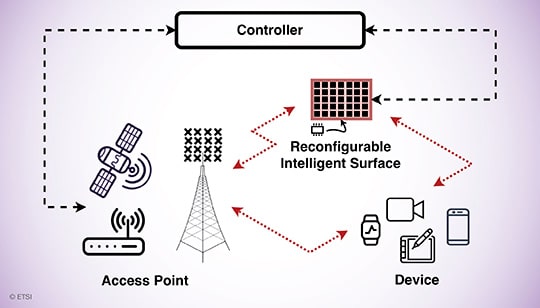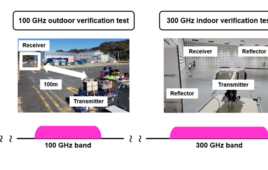A standards group will seek to define a technology for steering reflection of wireless signals.
| See Reconfigurable intelligent surfaces: Video interview with standards group chair for an interview with Dr. Arman Shojaeifard of InterDigital Europe, chair of the ETSI Reconfigurable Intelligent Surfaces Industry Specifications Group. |
At the September 2021 6G Symposium, intelligent reflecting surfaces came up in a session on the future of air interfaces. Today, that future took a step forward as ETSI announced the start of a group dedicated to specifying how these surfaces might perform.
Also called Reconfigurable Intelligent Surfaces (RIS), Reflecting Intelligent Surface, Large Intelligent Surface, Smart Repeater, and Holographic Radio, these surfaces could enhance wireless communications as part of 6G. According to the press release, ETSI’s Industry Specification Group on Reconfigurable Intelligent Surfaces (ISG RIS) will review and establish global standardization for RIS technology. According to the release, the group will “work towards defining use cases, covering identified scenarios, and clearly documenting the relevant requirements with a view to pave the way for future standardization of the technology.”
If RIS is new to you, there are numerous online resources that can help. The technical paper “Reconfigurable Intelligent Surfaces: A Signal Processing Perspective With Wireless Applications” describes RIS as “a two-dimensional surface of engineered material whose properties are reconfigurable rather than static. For example, the scattering, absorption, reflection, and diffraction properties can be changed with time and controlled by software.” Similar to beamforming already used in 5G, RIS lets a surface adjust its characteristics to reflect a signal to a desired destination. The differences come in that the RIS reflects signals in a controlled manner as opposed to beamforming, which transmits signals. Using light as an analogy, think of RIS as a surface of tiny mirrors that direct a beam of light to a desired location.
RIS creates a “smart radio environment in that it adjusts the amplitude and phase of an incoming signal, causing it to reflect to a desired location. Although the surface itself is mostly passive, RIS needs a controller (Figure 1) running signal-processing algorithms. Think of each element in the surface as a reconfigurable analog filter that alters the amplitude and phase of the incoming signal, thus adjusting how it reflects from the surface. Because a signal can hit more than one element, each element must adjust the reflections differently, sending the controlled reflection to a target. RIS can, therefore improve wireless signal strength by reflecting signals around obstacles such as buildings.

Figure 1. A Reconfigurable Intelligent Surface creates a controlled reflection, sending an incoming signal to a specified location. Source: ETSI.
Professor Emil Björnson of Linköping University in Sweden, the paper’s lead author, has recorded several YouTube videos on the subject. See “Fundamentals of Intelligent Reflecting Surfaces” below.





Tell Us What You Think!